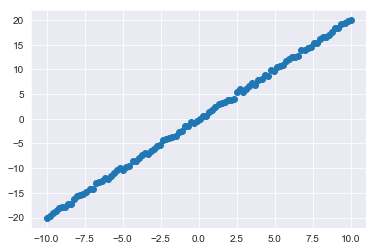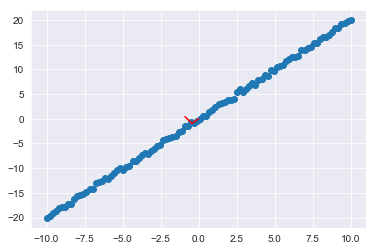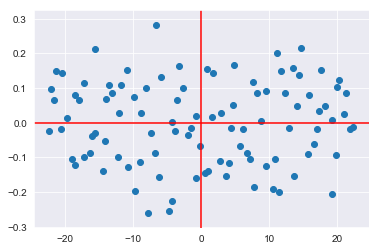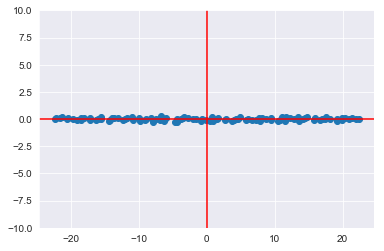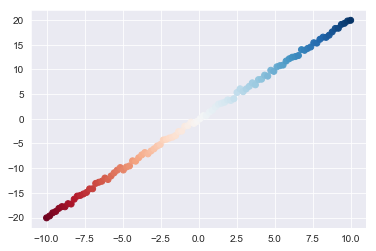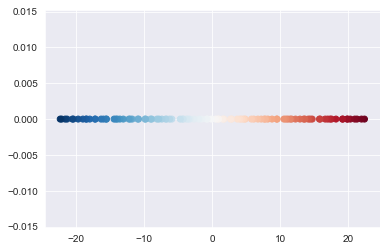Now that you've seen the curse of dimensionality, it's time to take a look at a dimensionality reduction technique! This will help you overcome the challenges of the curse of dimensionality (amongst other things). Essentially, PCA, or Principal Component Analysis, attempts to capture as much information of the dataset as possible while reducing the overall number of features.
You will be able to:
- Explain use cases for PCA
- Explain at a high level what PCA does
- Implement PCA algorithm using scikit-learn library
First, you need some data to perform PCA on. With that, here's a quick dataset you can generate using NumPy:
import numpy as np
x1 = np.linspace(-10,10,100)
x2 = np.array([xi*2 + np.random.normal(loc=0, scale=.5) for xi in x1]) #A linear relationship, plus a little noise
X = np.matrix(list(zip(x1,x2)))x2 = np.array(x2)Let's also generate a quick plot of this simple dataset to further orientate ourselves:
import matplotlib.pyplot as plt
import seaborn as sns
%matplotlib inline
sns.set_style('darkgrid')
plt.scatter(x1,x2);Now onto PCA. First, take a look at how simple it is to implement PCA with sci-kit learn:
from sklearn.decomposition import PCA
pca = PCA()
transformed = pca.fit_transform(X)And you can once again plot the updated dataset:
plt.scatter(transformed[:,0], transformed[:,1]);pca.components_array([[-0.44686606, -0.89460087],
[-0.89460087, 0.44686606]])
pca.mean_array([ 7.10542736e-17, -1.79079789e-02])
Let's take a look at what went on here. PCA transforms the dataset along principle axes. The first of these axes is designed to capture the maximum variance within the data. From here, additional axes are constructed which are orthogonal to the previous axes and continue to account for as much of the remaining variance as possible.
For the current 2-d case, the axes which the data was projected onto look like this:
plt.scatter(x1,x2);
ax1, ay1 = pca.mean_[0], pca.mean_[1]
ax2, ay2 = pca.mean_[0]+pca.components_[0][0], pca.mean_[1]+pca.components_[0][1]
ax3, ay3 = pca.mean_[0]+pca.components_[1][0], pca.mean_[1]+pca.components_[1][1]
plt.plot([ax1,ax2], [ay1,ay2], color='red')
plt.plot([ax2,ax3], [ay2,ay3], color='red');So the updated graph you saw, is the same dataset rotated onto these red axes:
plt.scatter(transformed[:,0], transformed[:,1]);
plt.axhline(color='red')
plt.axvline(color='red')<matplotlib.lines.Line2D at 0x1a190a4d68>
Note the small scale of the y-axis. You can also plot the transformed dataset on the new axes with a scale similar to what you saw before:
plt.scatter(transformed[:,0], transformed[:,1]);
plt.axhline(color='red')
plt.axvline(color='red')
plt.ylim(-10,10)(-10, 10)
Again, this is the geographical interpretation of what just happened:
Typically, one would use PCA to actually reduce the number of dimensions. In this case, you've simply reparameritized the dataset along new axes. That said, if you look at the first of these primary axes, you can see the patterns encapsulated by the principle component. Moreover, sci-kit learn also lets you quickly determine the overall variance in the dataset accounted for in each of the principle components.
pca.explained_variance_ratio_array([9.99917201e-01, 8.27993112e-05])
Keep in mind that these quantities are cumulative: principle component 2 attempts to account for the variance not accounted for in the primary component. You can view the total variance using np.cumsum():
np.cumsum(pca.explained_variance_ratio_)array([0.9999172, 1. ])
To help demonstrate the structure captured by the first principal component, observe the impact of coloring the dataset and then visualizing the first component.
plt.scatter(x1,x2, c=sns.color_palette('RdBu', n_colors=100));plt.scatter(transformed[:,0], [0 for i in range(100)] , c=sns.color_palette('RdBu', n_colors=100))<matplotlib.collections.PathCollection at 0x1a1c36f8d0>
The theory behind PCA rests upon many foundational concepts of linear algebra. After all, PCA is re-encoding a dataset into an alternative basis (the axes). Here's the exact steps:
- Recenter each feature of the dataset by subtracting that feature's mean from the feature vector
- Calculate the covariance matrix for your centered dataset
- Calculate the eigenvectors of the covariance matrix
- You'll further investigate the concept of eigenvectors in the upcoming lesson
- Project the dataset into the new feature space: Multiply the eigenvectors by the mean centered features
You can see some of these intermediate steps from the pca instance object itself.
pca.mean_ #Pulling up the original feature means which were used to center the dataarray([ 7.10542736e-17, -1.79079789e-02])
pca.get_covariance() #Pulling up the covariance matrix of the mean centered dataarray([[ 34.35023637, 68.7387464 ],
[ 68.7387464 , 137.6253672 ]])
pca.components_ #Pulling up the eigenvectors of the covariance matrixarray([[-0.44686606, -0.89460087],
[-0.89460087, 0.44686606]])
In this lesson, you looked at implementing PCA with scikit-learn and the geometric interpretations of principle components. From here, you'll get a chance to practice implementing PCA yourself before going on to code some of the underlying components implemented by sci-kit learn using NumPy.
